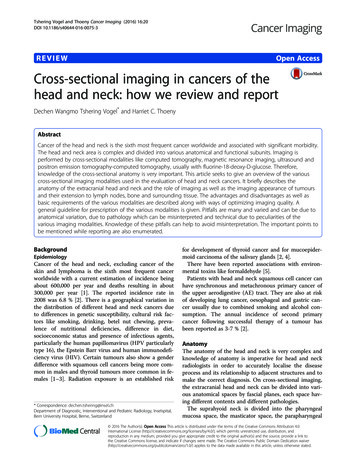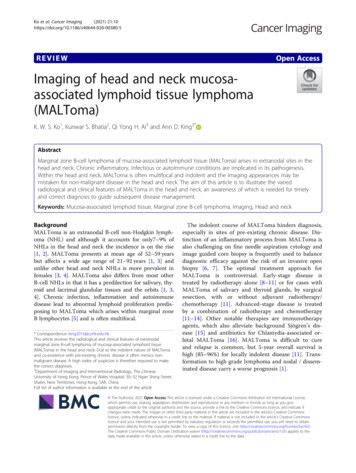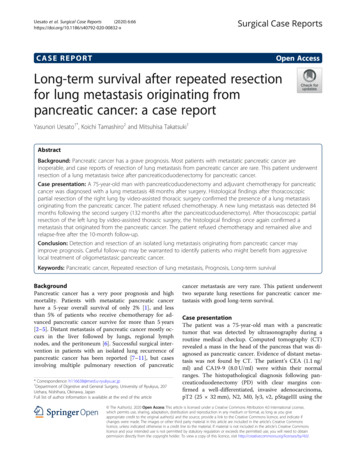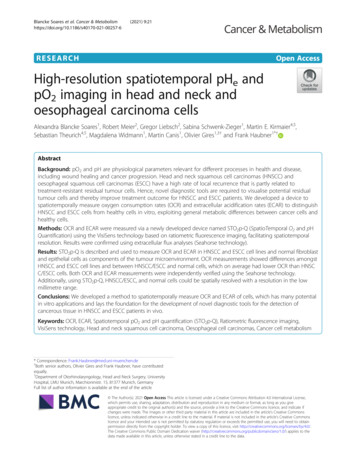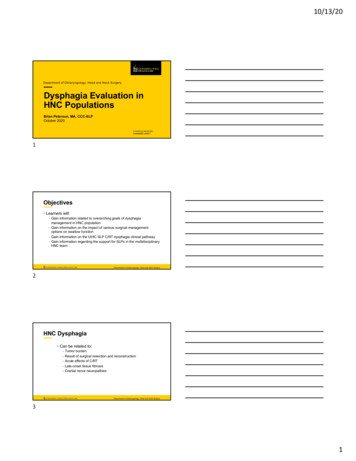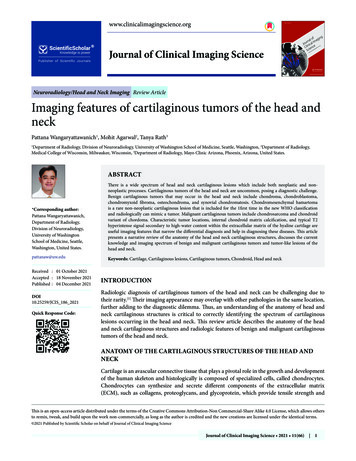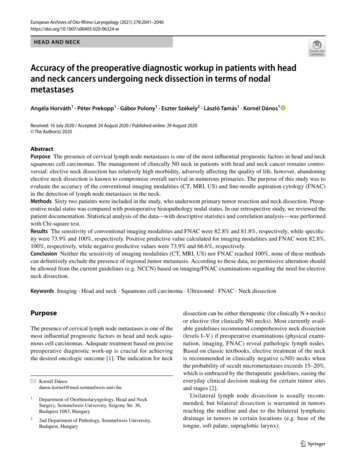
Transcription
Journal of American Science, 2013; 9(11)http://www.americanscience.orgHead and Neck Swellings Resection Control Using Intelligent Control Based onMach3 and Artcam Based on MRI ImageG.G.N.Geweid1, A.A.A. Nasser2, M.Z. mostafa3 and D.M.El-Hennawi4, A. Geneid41Electrical Engineering Department, Faculty of Engineering, Alexandria University, Egypt,Arab Academy for Science and Technology & Maritime Transports, Alexandria, Egy3Electrical Engineering Department, Faculty of Engineering, Alexandria University, Egypt.4Faculty of Medicine, Suez Canal University, Egypt.gamal dr1430@yahoo.com2Abstract—In this paper a motion control system of a Head And Neck Swellings Resection (HANSR) Tool blade is described. Inmany cases, the task of accessing the location of the tumor in Head and Neck is very complicated. The abnormal tissues have to beremoved without causing any injury in the adjacent structures during surgery. This paper introduces a method that uses theconventional way of ambiguous position to the blade, after which the intelligent HANSR Tool employs a program that allows theblade tool itself to autonomously determine the action required to move the blade into that position. Also, this blade is connected tothree Stepper motors. A Stepper motor is chosen for the HANSR Tool blade and the author also presents how to choose this motor.The HANSR Tool blade is with single degree of freedom and motion control system for it is selected using MACH3 andARTCAM algorithm. This paper mainly focuses on how to apply MACH3 and ARTCAM algorithm to Control system design. Thesystem is designed to allow the motor to move the HNST blade to proper angular position according to the head and neck diagram.The method is applied to a set of real data of 20 MRI images with normal and abnormal tumors. The practice showed that the systemhas the characters of good performance and low cost, so it can be widely used in resection of most Head and Neck Swellings. Inexperiments, an intelligent HANSR Tool was successfully engineered to use MACH3 and ARTCAM algorithm to identify tumorlocation and autonomously move toward a target and the system has the characters of good performance and low cost using thistechnique, so it can be widely used in resection of most Head and Neck Swellings.[G.G.N.Gouid, A.A.A. Nasser, M.Z. mostafa and D.M.El-Hennawi. Head and Neck Swellings Resection ControlUsing Intelligent Control Based on Mach3 and Artcam Based on MRI Image. J Am Sci 2013;9(11):45-52].(ISSN: 1545-1003). http://www.jofamericanscience.org. 8Keywords— blade motion control; driving circuit; stepper motor; MACH3; ARTCAM; HANSR Tool;I.composed of cells that exhibit unrestrained growth in thebrain (3).This paper deals with a new motion control technique forhead and neck tumors removal operation. In this paper, weuse three Permanent Magnet Stepper Motors (PMSM) inorder to make a robust controller because PMSMs havethe capability to cover and minimize all uncertainties ofthe model.A Stepper motor is an electromechanical nonlinear motorwhich has been designed to rotate in specific angularposition. Stepper motors require simple and cheap controllersfor position and speed control. Therefore, these motorsare very popular in medical applications and are widelyused in different industries(6). Permanent magnet steppermotors have become a popular alternative to the traditionallyused brushed DC motors (BDCM) for many highperformance motion control applications for severalreasons: better reliability because of the elimination ofmechanical brushes, better heat dissipation as there are norotor windings, higher torque-to-inertia ratio, lower priceand easy interfacing with digital systems(7). The shaft of astepper motor rotates in discrete step increments whenelectrical command pulses are applied to it in the propersequence (8). Rotation of the motors has several directrelationships to these applied input pulses. So, the changesin shaft position can generate oscillations or cause a longdelay in the output (torque) which is related to selectedINTRODUCTIONCurrently, resection operation of Head and Neck Swellings ismanual using classic tools (1). Motion control is one of themain factors that prevent the Automatic Operation. TheseSwellings are located in complicated regions of the head andneck diagram. Motion control design to access the desiredlocation of the tumor is to be removed without causing anyinjury of the adjacent structures (2).Head and neck tumor consists of heterogeneous groups oftumors with a multitude of histologies. It is the sixth mostcommon sited neoplasm in the body today with 500,000cases expected every year(3). Early diagnosis and treatmentare important in improving survival in any form ofmalignancy (4). Any delay may lead to more advanceddisease, decrease cure rate and effectiveness of treatment,leading to higher morbidity and mortality (5). Head and necktumor usually originates in the lining of the mouth, nose,throat, or sinuses, or in glands in the neck. There are severaltypes of head and neck tumor, including oral tumor (e.g.,tongue tumor, lip tumor, mouth tumor) and throat tumor(e.g., laryngeal tumor) (2). The symptoms of Head and necktumors depend on tumor size, type, and location. Symptomsmay be caused when a tumor presses on a nerve ordamages a certain area of the Head and neck. They alsomay be caused when the Head and neck swells or fluidbuilds up within the skull. Head and neck tumors ience.org45
Journal of American Science, 2013; oday, PMSMs are widely used in numerousmotion control applications such as robotics, printers, anddigital control circuits etc. Recently, various methods havebeen introduced for rotor positioning control anddetermination of proper control signals in PMSMs (10). It isimportant that a nonlinear controller will be required dueto nonlinear structure of PM stepper motors while outputtracking problem is represented(11). In recent decades,adaptive algorithms have been applied to PM stepper motorsmore than before. Also, motion control system of HANSRTool blade is based on MACH3 and ARTCAM algorithms.These algorithms are deals with the 3D and 2D images. Tobe able to control a motion process, the precise position ofobjects needs to be direct access. Using a MACH3 andARTCAM algorithms and processing the informationcontained in the acquired images allow controlling theposition of a HANSR tool actuator or to guide a bladetowards a target object. To improve the precision, thelooking part, and the actual control of the position, themoving part, are included in a MACH3 and ARTCAMalgorithms. Putting an object in the correct place with theright amount of force and torque at the right time is essentialfor efficient Head and Neck Swellings Resection operation.MACH3 is a software package that runs on a PC and turnsit into a very powerful and economical Machine Controller(12). It is a very flexible program designed to controlmachines such as milling machines, lathes, plasma cutters,and routers. Also, MACH3 can store the properties of up to256 different tools. If, however, your machine has anautomatic tool changer or magazine, you will have to controlit yourself. Also, MACH3 provides program macrocapability, but you must do the programming (12). MACH3will control up to six axes simultaneously, coordinating theirmovement with linear interpolation or perform circularinterpolation on two axes (out of X, Y or Z) whilesimultaneously linearly interpolating the other four with theangle being swept by the circular interpolation. The HANSRTool can thus move in a tapering helical path if required. Thefeed rate during these moves is maintained at the valuerequested by your part program, subject to limitations of theacceleration and maximum speed of the axes. You can movethe axes by hand with various jogging controls. MACH3 canswitch the blade on, rotating in either direction, then switch itoff. It can also control the rate at which it rotates (rpm) andmonitor its angular position for resection of Head and NeckSwellings.In this study, The ARTCAM algorithm is designed basedon images for visual servo control of a HANSR tool ispresented. ARTCAM Program is a unique software programwhich allows users to easily create impressive, high qualityblade path. ARTCAM allows importing 3D models or filesfrom other CAD packages, which can be added to makecomplex and intricate 3D points. This algorithm transformsimages into G-code (G-code is sometimes called Gprogramming language). In fundamental terms, G-code is alanguage in which people tell computerized machine toolswhat to make and how to make it. The "how" is defined byinstructions on where to move to, how fast to move, andthrough what path to move far more quickly than is possiblehttp://www.americanscience.orgusing conventional methods. The problem with these imagesis that most of them are based on pixels (e.g. jpg, bmp, gif),rather than the vector type entities (lines, circles, arcs; e.g.dxf, dwg) that are needed for HANSR tool paths. Identify thetumor location with extensive CAD drawing tools on MRIimages, then create blade path based on G-code related totumor location. This allows surgeon to move the HANSRTool blade to proper angular position according to the inputimages. Finally, the combination of MACH3 and ARTCAMalgorithms identifies the target and actual positions. It is thena natural step in implementing a motion control system. Thisallows oncologists and Ear, Nose and Throat (ENT) surgeonsto control the blade motion and to see the results in real timeduring eradication operation. As well as giving totalflexibility in the resection of most Head and Neck Swellings.Finally the software including motor controlling program,communication program and human-machine interfaceprogram are designed.We would advise the following points be considered beforestarting. The maximum and minimum speeds (rpm) that theblade will experience in normal operation, Pulley Ratio (anaccurate ratio is required for MACH3 to be able to calculatethe correct blade path to control the removal operation bymotor), Motor Output Signal Setup for MACH3 Pins andPorts, blade path input required for MACH3 Ports and Pins,The correct blade path Setup under MACH3 Ports and Pins.II.SYSTEM DESCRIPTIONSThe overall structure of HANSR Tool is mainly composed ofPC, MACH3 and ARTCAM algorithms, driving circuit,communication circuit and stepping motor. Its structurediagram is shown in Fig. 1.Figure 1. Block Diagram of the HANSR Tool System.A.ARTCAM ALGORITHMARTCAM algorithm can be generated by the G-code ofHANSR Tool blade path from inserted 2D or 3D MRIimages. The G-code standard set of instructions forprogrammed machining is used, generated from standardCAD/CAM packages. Also, this algorithm has been designedto give a smooth motion controller of HANSR Tool blade.In this paper, ARTCAM algorithm moves the HANSR Toolblade to proper angular position according to the input bladepath. This is because the determination of the direction andeditor@americanscience.org46
Journal of American Science, 2013; 9(11)http://www.americanscience.orgthe entry points of Head and Neck to target only the Swellingtissues region and to avoid other organs is a difficult job.The ARTCAM algorithm is used as an identifier toidentify the tumor location from the brain MRI images asshown in fig.2. In addition, the Calculation technique for thetool path motion direction in computed tomography imagesis based on oncologists’ and ENT surgeons’ experience.After that, testing of this path should be performed using atest image set to verify the efficiency of the constructed pathand reach the optimum path allowing identification to takeplace. This allows oncologists and ENT surgeons to accessthe location of the tumor in Head and Neck duringeradication operation and to see the results in real time aswell as giving total flexibility in the tumor removaloperation. This is very important because the tumor has to beremoved without causing any lacerations in the adjacentstructures during entry or exit from the tumor area as shownin fig. 2.and ENT surgeons. The software provides functionsincluding system configuration, combination codegenerator, program editor, terminal emulator, andprogram tester. With communication to the PC card andthe indexer, the program can be used to control thesystem upon selection of the type of motor controller asshown in fig.3. The MACH3 algorithm automaticallygenerates controller code for the basic system set-upparameters such as distances and speeds. The editor is usedto provide a programmable environment to create blocks orlines of code.Figure 3. MACH3 software control panelC.Stepper MotorA stepper motor is an electromechanical device whichconverts electrical pulses into discrete mechanicalmovements. The shaft or spindle of a stepper motor rotatesindiscrete step increments when electrical command pulsesare applied to it in the proper sequence. Rotation of themotors has several direct relationships to these applied inputpulses (11, 13). The stepper used in this study has 200 stepsper revolution. The relationship between steps perrevolution and step angle is given by the following formula;Figure 2. Head and neck tumors location diagramB.MACH3 ALGORITHMIn this study, MACH3 2.0 is used to control themotors and interface between the user input and thedriver circuit. MACH3 is low cost software available itimplements motor control from manual input or programmedblade control. There are some requirements for proposedsystem design. The first fact of MACH3 is to provideinexpensive, programmable logic control and interfacingto external devices. The second option is that there are about32 I/O pins required for interfacing various input and outputdevices. MACH3 is used in this study because it iscompatible with all these requirements. MACH3 generatesstep pulses and direction signals to perform the steps definedby a G-Code part program and sends them to the I/O ports.When MACH3 receives a command from the ARTCAM, it will be calculated into the control pulse signal bythe algorithm and outputted through I/O port to driving thestepper motor. Its control is totally by computer and hasvision capability which leads its blade to certain places.After finding the target coordinates, the control orders aregiven to blade by computer through parallel port to theinterface circuit. These commands can turn off/on steppermotor through drive circuit in order to move blade tocorrect direction. The G-Code window and blade pathdisplays provide information from MACH3 to oncologists(1)It is found that the step angle is 1.8 degrees in a step. In thisstudy, The stepping motors are used to drive thepositioning tool blade in X and Y directions and thecutter in Z direction. The motors used are two phasebipolar stepping motors with 1.8 degrees per step. The ratedvoltage for one of them is 5 V DC and 3.2 V DC for theother.In this study, we have a standard step motor with 200steps per revolution. This motor is driven by a driver set to 5micro steps per full step. The motor is directly coupled tothe lead blade which has a pitch of 5mm per revolution.That means the axis will move 5mm for each revolution ofthe blade. So we’ll take the motors 200 steps multiply cience.org47
Journal of American Science, 2013; 9(11)http://www.americanscience.orgTABLE 1. Cable connection of X-Y axis cardby the drives 5 micro step. (200 X 5 1000). The driveneeds 1000 pulses (or steps) to turn the blade one revolutionthus making the axis move 5mm. So now we take those1000 steps and divide by the pitch of the blade, which is 5.(1000 / 5 200). In other words we need 200 steps to moveone unit or mm.D. Stepper Motor Driver CircuitThe drive circuits are used to drive the two phasebipolar X,Y and Z stepper motors. The drive circuit to drivethe X and Y axes is given in Fig. 4. while the circuit fordriving the Z axis is given in Fig. 5.The principalfunction of the driver circuits is to generate motor phasesequences.In these circuits L298 dual full-bridge driver and L297stepper motor controller IC are used as motor drive circuitcomponents. There are three control signals, which are usedto control each of the motor axes, as “clock” to give thestepping command, “direction” to determine the sense ofrotation of the motor and “half/full” to decide whether tooperate in full or in half step mode(14). Although it ispossible to choose full or half step mode, only the full stepmode is used as indicated before. Normal drive mode ispracticed to the full step mode and it is selected by a lowlogic level on Half/Full input (Full step mode)(8,13). Thecable connection used between the stepper motor controllercircuit inputs to the proper outputs in order to drive the stepmotors are given in Table 1, Table 2 and Table 3 .TABLE 2. Cable connection of Z axis cardTABLE 3. Cable connection of cards and supplyFigure 4. (X-Y) Axis Drive anscience.org48
Journal of American Science, 2013; 9(11)http://www.americanscience.orgFigure 5. Z Axis Drive CircuitE.Digital I/O1) Requirements for Digital I/O :Base drivecircuit is designed such that the control signals are atTTL logic level which is 0 or 5 Volts. In order to havemaximum efficiency in the system, these control signalsmust be as fast as possible (14). This speed dependson the torque requirement from the motor, simplythe physical characteristics of the material are drilled,and the control scheme of the motors. Closed-loopcontrol scheme will require faster signals than theopen-loop case. Experimental results show that with theopen-loop control scheme, motor types and materialgiven, 5msec, as the step motor pulse duration isadequate. These signals may be generated by speciallydesigned, commercially available professional devicesthat are sold by various vendors with respectivelyhigher prices. Another solution for digital I/O is utilizingthe parallel port which is available on every personalcomputer (8,15).2) Parallel Port of PC :Parallel port is a standardI/O interface for all PCs. Today, there exists at least oneparallel port for various applications such as connectionof a printer or a hard-key. In Table 4, the base hardwareaddresses of the parallel ports are given.All ports are defined at TTL (Transistor-TransistorLogic) logic levels (An electrical "high" on the pin isTTL high, 2.4 to 5 volts. An electrical "low" is TTLlow, 0 to 0.8 volts.). Data port is driven by the highimpedance octal D-type flip-flop (74LS374). This ICcan source 2.6 mA while it can sink 24 mA. As thesevalues are relatively low, it may be necessary toamplify the outputs for specific applications. Controlport pins are driven by the 7405 inverter IC which maysupply 1 mA up to 7 mA. In parallel port applications,for not to damage the mainboard the driver circuitsshould fulfill the requirements given above.In Fig. 6, the block diagram of the parallelinterface is given while in Fig. 7. the illustration of aparallel port is shown.TABLE 4. Parallel Port Address TableThere are three types of I/O interface in the parallel portnamely data port, status port and control port. Data Port: There exist eight digital outputterminals that are accessed by dataports. Status Port: There exist five digital inputterminals, of which one of them is inverted, thatare accessed by status ports. Control Port : There exist four digital outputterminals, of which three of them are inverted,that are accessed by control ports.Figure 6. Block diagram of the parallel interfaceFigure 7. Parallel Port I/O nscience.org49
Journal of American Science, 2013; 9(11)III.http://www.americanscience.orgSYSTEM OPERATIONinch. In reality a step per unit value as high as 30.000will greatly reduce the speed at which the HANSR Toolblade can move. This is for X Axis as shown in fig.8.Then do the same for the Y and Z axis.Now that we know the required motor revolution perunit of travel, we can finally calculate:MACH3(s/u) MACH3 (s/r) Motor (r/ u)(2)Where s: step, u : unit and r: revolutionFig. 9. Shows the dialog for Configuration MotorTuning. Select the axis that you are configuring, andenter the calculated value of MACH3 steps per unit inthe box labeled Steps per unit. This value does not haveto be an integer. Whatever the number, it is a specific,calculated number determined by the driveconfiguration.This study is designed to control the blademovement system of the HANSR Tool path. Therefore athree Stepper motors is used. These motors are used tocontrol the direction of the blade for X, Y and Z-axis. AMACH3 is also used to drive the three motors. Motorsconvert current into torque which produces motion.Motor’s torque properly to move the blade at therequired speed and acceleration must be determined foreach motion.When the operation is started, the blade movesforward to the target position and then moves upward tothe tumor location. Then the tool blade rotates in orderto pick up the tumor tissues for the blade after catchingthe desired tumor tissue from the operation area ortumor location, the blade moves downward and movesbackward to the operating area.A. Stepper Motor ControlOne of the critical points in the software is to sendthe data to the driver circuit properly i.e. to the rightaxis with the right timing. To determine the movementaxes that should in fact determine which bits of theparallel port to change. According to the axes and movement determined, thesignals are generated and sent to the driver circuit.The first thing in the tuning process is to calculatehow many steps per unit of travel we have. This dependson a few things: The amount of steps per revolution. The step resolution of the motor drive, full step,half step, 5, 10, 100 micro steps etc. The reduction ratio between the motor shaft andlead blade.In this design, a minimum step of 0.0005” waschosen. A stepper motor (ten micro-steps) gives 2000steps per revolution so a 5:1 reduction (belt or gear box)is needed between the motor shaft and lead blade tomake one step equal to 0.0005” of travel [0.0005” 5”/(2000 x 5)], and because of the 5:1 gear reductionone revolution of the stepper motor will result in 1” oftravel. With this design, if we get 500 rpm from thestepper, travel will be 500 inches per minute, or 8.33inches per second. The rapid feed of 60” would,neglecting acceleration and deceleration time, take areasonable 7.2 seconds. [60” / 8.33 7.2].Figure 8: Motor Tuning and Setup by MACH3 software.Figure 9. MACH3 Motor Tuning Configuration setupC.The blade speed and Pulley Ratio calculationsThe maximum speed is the speed at which the bladewill rotate when the motor is at full speed. Full speed isachieved by 100% pulse width modulation (PWM) andat the set value on Motor Tuning “blade Axis” for Stepand Direction. If a speed greater than the MaximumSpeed is requested, MACH3 will display a warning anduse the Max Speed value. If the Minimum Speed featureis used, its value for each pulley should be calculated asa percentage of the maximum speed, with thepercentage determined by the minimum speed rating ofthe motor or controller. It is, also the minimumpercentage PWM signal ratio. For this system, wechoose a PWM of less than 20% gives unacceptableB. Drive Circuit Operation of MACH3 Motor setupThe drive needs 2000 pulses, or steps, to turn the motorone revolution. But since we have the 3 to 1 beltreduction between the motor and the blade we need tomultiply the 2000 by 3 to make the screw turn onerevolution. 6000 steps will make the blade turn onerevolution, making the axis move 1/5 of an inch. Tomake the axis move one inch we need the blade to makefive revolutions so 6000 X 5 30.000 steps per unit ence.org50
Journal of American Science, 2013; 9(11)http://www.americanscience.orgmotor performance, then the minimum speed should becalculated as 20% of the maximum speed. If a speedlower than the minimum is requested, then MACH3will display a warning and use the minimum acceptablespeed. In this study, there is a maximum speed of 1600rpm on pulley 4 and a minimum speed of 320 (20% of1600), an S200 command would display a warning andthe minimum speed of 320 would be used. This featureis to avoid operating the motor or its motion controllerat a speed below its minimum rating. MACH3 uses thepulley ratio information as follows: When the part program executes an S-word or a valueis entered into the Set Speed DRO, then the value iscompared with the maximum speed for thecurrently selected pulley ratio. If the requestedspeed is greater than the maximum, then an erroroccurs. Otherwise, the percentage of the maximum for thepulley that has been requested is used to set thePWM pulse width, or Step pulses are generated toproduce that percentage of the maximum motorspeed as set in Motor Tuning for the “blade Axis.”In this study, suppose the maximum blade speed forPulley 1 is 1500 rpm. S1600 would be an error.An S200 command would give a PWM pulse width of40% (600/1500). If the maximum Step and Directionspeed is 3600 rpm, then the motor would be “stepped” at1440 rpm (3600 x 0.4).The Ratio value can be set if theactual speed of the blade is for any reason different thanthe measured speed being seen by the tachometer. Thismay occur if, because of physical constraints, the speedsensor must be mounted at a point in the spindle drivetrain that has additional gearing between its location andthe blade movement. Check reversed if, because ofgearing, blade rotation of a pulley setting is opposite tothe rotation of other pulley settings.software. As already mentioned, ARTCAM algorithmis used to move the HANSR Tool blade to properangular position and check the end position of theblade path as shown in fig.11. Drive Circuit is used tocontrol each of the motor axes, to give the steppingcommand, “direction” to determine the tumor locationto pick up the desired target. To make AutomaticSetting of Steps per Unit, calculate the steps per unit bymeasuring the gearing of motor axis drive. ThenMACH3 can calculate the steps per unit that should beconfigured, as shown in Fig.12.The operation of the system is supervised by theMACH3 algorithm related to blade path resulting fromARTCAM algorithm. The three Stepper motors areused to move the blade to X, Y and Z-axis according toG-Code of blade path as shown in fig.13.The HANSR Tool Stepper motors are controlled bythe operator the blade path to get desired tumorlocation. In this system, oncologists and ENT surgeonsmust select the type of image class firstly, and thenopen this image in an ARTCAM algorithm. After that,start the MACH3 algorithm to start the automaticeradication operation. When the MACH3 algorithm isstarted, the stepper motors will rotate according to thepredefined data of MACH3 algorithm.Figure 10. Pulley Ratio and blade speed calculations.IV.TEST AND RESULTThe motion control system of a HANSR Tool blade isoperated by the ARTCAM and MACH3 2.0 software.The algorithm is applied to 20 sets of real data in theform of images for the adenoid and head and neck tumortissue before and after removal operation. These imagesare classified to 12 sets of classifications (A to L)depending on the tumor location identification. Enterthese images to the ARTCAM algorithm then start toolpath simulation. Since this software consists of manyseparate path way programs which pulse a largenumber of additional G-code files, it is the fact thatoncologists and ENT surgeons decide to use thishttp://www.americanscience.orgfigure .11. ARTCAM algorithm moves the HANSR TOOL bladeto proper angular position according to the input MRI head andneck images.editor@americanscience.org51
Journal of American Science, 2013; e 12. Automatic Setting of Steps per Unit[11][12][13][14][15]figure 13. The Program Run screen, with G-Code window of bladepath out.V.AN1495, Application Note, “Microstepping Stepper MotorDrive Using Peak Detecting Current Control”, ThomasHopkins,(2010),pp 4-9.M. Zribi, H.S. Ramirez and A. Ngai, “Static and DynamicSliding Mode Control Schemes for a Permanent Magnet StepperMotor”, International Journal of Control, Vol. 74, pp. 103-117,2001.S.S. Ge, C.C. Hang and T. Zhang, “A Direct Method for RobustAdaptive Nonlinear Control with Guaranteed TransientPerformance”, Systems and Control Letters, Vol. 37, pp. 275284, 2002.Perriard, Y., Scaglione, O. and Markovic, M. “Self-SensingMethods for PM Motors in Mechatronics Applications”.Proceedings of the IEEE/ASME International Conference onAdvanced Intelligent Mechatronics (AIM 2010).ArtSoft USA. software incorported; MACH3 ControllerSoftware Installation and ConfigurationVersion 3; 2010.SGS Thompson Microelectronics, “Stepper Motor Controllers”,August 2010.Semih Mümin Ateş, “A PC Controlled Three DimensionalMachine Tool Control System”, METU MS Thesis, Dec. 2008.Oliver Faugeras, “Three Dimensional Computer Vision:A Geometric Viewpoint”, MIT Press, 1998.CONCLUSIONThis paper presented an HANSR Tool blade motion controlsystem using a MACH3 and ARTCAM algorithm. The designsequence of the current system is described and parameters ofthree stepper motors driving are calculated at optimal values.In this design, the MACH3 and ARTCAM algorithm are usedto build a high performance of swellings automatic removaloperation. This is the technique that causes minimum injury ordamage to the healthy tissues adjacent to the swelling siteduring entry or exit from the target area. The experimentalresults verify the performance of the blade motion control.11/21/2013ACKNOWLEDGMENTI can't find the suitable words to express about my deepest grateful to Prof.Abed Elmeneam A.A. Nasser for his constant professional support, excellentexpertise and motivating
ARTCAM Program is a unique software program which allows users to easily create impressive, high quality blade path. ARTCAM allows importing 3D models or files from other CAD packages, which can be added to make complex and intricate 3D points. This algorithm transforms images into G-code (G-code is sometimes called G .
